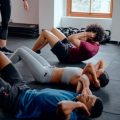Understanding Tendon and Ligament Grafts in Orthopedic Rehabilitation
Overview of Common Graft Procedures in the U.S.
Tendon and ligament injuries are frequent in sports, work-related accidents, and daily life. When these tissues are badly damaged, surgery may be needed to restore function. In the United States, orthopedic surgeons often use tendon or ligament grafts to repair or reconstruct these structures. Physical therapists play a key role in helping patients recover after these procedures.
Types of Grafts Used
| Graft Type | Description | Common Uses |
|---|---|---|
| Autograft | Tissue taken from the patients own body | ACL reconstruction, Achilles tendon repair |
| Allograft | Tissue taken from a donor (cadaver) | Rotator cuff repairs, multi-ligament knee injuries |
Why Graft Choice Matters for Rehab
The choice between autograft and allograft impacts how physical therapists approach rehabilitation. For example, autografts may require extra care at the donor site, while allografts might have a slower incorporation rate into the body. Understanding these differences helps therapists design individualized plans that promote safe healing and optimal outcomes.
Relevance to Physical Therapy Practice
In everyday clinical practice across the U.S., physical therapists must stay updated on surgical techniques because rehabilitation protocols can vary depending on the graft type and surgical approach. Therapists need to collaborate closely with surgeons and educate patients about what to expect during recovery. This knowledge also helps therapists address common patient concerns, such as graft strength, healing timelines, and activity restrictions.
Principles of Evidence-Based Rehabilitation Protocols
Understanding Evidence-Based Timelines in Graft Rehabilitation
Physical therapists working with tendon and ligament graft patients must stay up-to-date with current research to ensure safe and effective recovery. Evidence-based rehabilitation timelines offer guidance on when to advance a patient through each phase of rehab. These timelines are based on healing biology, surgical techniques, and clinical outcomes research.
| Rehab Phase | Typical Timeline | Main Goals |
|---|---|---|
| Immediate Post-op | 0-2 weeks | Pain control, swelling reduction, gentle mobility |
| Early Mobility | 2-6 weeks | Gradual range of motion, light muscle activation |
| Strengthening | 6-12 weeks | Progressive loading, restore normal movement patterns |
| Advanced Training | 3-6 months | Functional strength, proprioception, prepare for return to sport/activity |
| Return to Activity/Sport | 6+ months (varies by graft type) | Full functional return, minimize reinjury risk |
Criteria for Progression: Moving Beyond the Calendar
While timelines provide a general guide, current best practice emphasizes criteria-based progression. This approach prioritizes patient readiness over fixed timeframes. Therapists assess factors such as pain levels, swelling, joint stability, range of motion, strength symmetry, and functional performance before advancing to the next stage. This helps prevent setbacks and supports optimal tissue healing.
Common Criteria for Advancing Rehabilitation Stages:
- No significant pain or swelling after activity or exercise sessions
- Adequate range of motion compared to the uninvolved side
- Sufficient muscle strength (often 70-90% symmetry is required for late-stage progressions)
- Ability to perform functional tasks safely (such as squatting, single-leg hopping, or jogging for lower extremity injuries)
- Surgical site stability confirmed by physical examination and/or surgeon clearance
The Importance of Individualized Care Plans in Graft Rehab
No two patients are exactly alike—even with similar surgeries. Factors like age, activity level, previous injuries, and personal goals all impact recovery. Physical therapists play a crucial role in tailoring care plans to meet each patients unique needs. Using evidence-based guidelines as a foundation while customizing interventions ensures that every individual has the best chance for a full and lasting recovery.
![]()
3. Innovative Modalities and Technology Integration
Modern tendon and ligament graft rehabilitation goes far beyond traditional exercises. Physical therapists across the U.S. are embracing cutting-edge adjuncts that can make a real difference in patient recovery. Let’s break down three of the most exciting advances making waves in clinics today.
Blood Flow Restriction Training (BFRT)
BFRT involves using specialized cuffs or bands to partially restrict blood flow to a limb during low-load exercise. This technique allows patients to gain muscle strength and mass without putting too much stress on healing tissues—a huge benefit after graft surgeries.
| Key Benefits | How It Helps Rehab |
|---|---|
| Increased muscle strength with lighter loads | Protects the graft site while still promoting muscle growth |
| Shorter rehab sessions | Speeds up functional recovery and return to activity |
| Safe for early-stage rehab | Minimizes risk of overloading the healing tissue |
Neuromuscular Electrical Stimulation (NMES)
NMES uses electrical impulses to stimulate muscles, helping patients who may struggle to activate certain muscles after surgery. This technology is especially helpful for rebuilding quadriceps strength after ACL reconstruction or similar procedures.
- Jumpstarts muscle activation: Great for early post-op when voluntary contraction is tough.
- Prevents atrophy: Keeps muscles engaged during periods of limited mobility.
- User-friendly devices: Many clinics provide at-home NMES units for ongoing rehab support.
Virtual Reality (VR) Applications
The use of VR in physical therapy is gaining popularity nationwide. VR systems immerse patients in interactive environments, making repetitive rehab exercises more engaging and motivating.
- Improved patient engagement: Fun games and challenges keep motivation high, especially for younger or tech-savvy patients.
- Real-time feedback: VR tracks movement quality and progress instantly, allowing for immediate adjustment.
- Cognitive involvement: Tasks can challenge both body and mind, supporting overall functional recovery.
Quick Comparison: Modern Rehab Adjuncts
| Modality | Main Use | Main Benefit | Typical Setting |
|---|---|---|---|
| BFRT | Strength training with low load | Muscle growth, joint protection | Clinic or home (with guidance) |
| NMES | Muscle activation/prevention of atrophy | Keeps muscles firing early in rehab | Clinic or home unit |
| VR Applications | Functional training, engagement | Makes rehab fun and interactive, tracks progress easily | Mainly clinic-based, some home options emerging |
The Takeaway for PTs in America Today:
If you’re working with tendon or ligament graft patients, consider how these innovative tools can fit into your treatment plans. Leveraging technology not only improves outcomes but also helps boost patient satisfaction—an important goal in every modern physical therapy practice.
4. Addressing Return-to-Activity and Return-to-Sport Decision Making
Understanding the Importance of Safe Progression
After tendon or ligament graft surgery, deciding when a patient can safely return to activities or sports is one of the most critical steps in rehabilitation. Physical therapists in the U.S. follow best practice guidelines to minimize re-injury risk and ensure the graft has adequately healed. A structured approach using objective criteria, rather than just time since surgery, helps guide these decisions.
Best Practice Guidelines for Return-to-Activity
Physical therapists consider several factors before progressing patients to higher-level activities or sports. These include:
- Graft integrity (confirmed through clinical examination and sometimes imaging)
- Resolution of pain and swelling
- Restoration of full range of motion (ROM)
- Sufficient strength—typically at least 85-90% compared to the uninvolved limb
- Neuromuscular control and balance
- Psychological readiness to return
Functional Testing Strategies Used in the U.S.
To objectively assess readiness for return-to-activity, therapists commonly use functional tests. These tests evaluate strength, agility, balance, and sport-specific skills. Here’s a summary of common functional tests:
| Test Name | Purpose | Description |
|---|---|---|
| Single-Leg Hop Tests | Assess lower limb power and symmetry | Patient hops forward on one leg; distance compared between limbs |
| Biodex Isokinetic Strength Testing | Measure quadriceps and hamstring strength deficits | Knee extension/flexion tested at various speeds using specialized equipment |
| Y-Balance Test | Evaluate dynamic balance and core stability | Standing on one leg, patient reaches in three directions with opposite leg |
| Tuck Jump Assessment | Identify jumping and landing technique flaws that may increase injury risk | Repeated tuck jumps observed for knee valgus, landing control, and fatigue signs |
| Agility Drills (e.g., shuttle run) | Test change-of-direction speed and neuromuscular control under stress | Sprint back-and-forth between cones; time and movement quality assessed |
Cultural Context: The U.S. Clinical Setting Approach
In American clinics, there is often collaboration between therapists, physicians, athletic trainers, and sometimes coaches. Shared decision-making is encouraged. Therapists typically educate patients about safe progression, setting realistic expectations based on their goals—whether returning to high school sports, recreational leagues, or demanding jobs like firefighting or construction.
Sample Return-to-Sport Criteria Checklist:
- No pain or swelling during daily activities or sport-specific drills
- Knee or joint ROM equal to the uninvolved side (within 5 degrees)
- Limb symmetry index ≥ 90% on hop tests and strength measures
- No compensatory movement patterns observed during agility tasks
- Patient expresses confidence and lacks fear of reinjury (assessed by questionnaires like the ACL-RSI scale)
- Physician clearance as needed for competitive athletes or high-risk jobs
5. Cultural, Social, and Insurance Considerations in the American Healthcare System
Understanding the American Context
Rehabilitation after tendon and ligament graft surgery isn’t just about exercises and protocols—it’s also shaped by unique factors within the United States. Physical therapists need to recognize how insurance coverage, social determinants of health, and cultural expectations influence a patient’s rehabilitation journey.
How Insurance Policies Affect Rehab
Insurance is a big part of healthcare in America. The type and amount of coverage can directly affect a patient’s rehab experience. For example, some insurance plans limit the number of allowed therapy visits or only cover certain services. This can lead to patients stopping rehab early or skipping important sessions. Here’s a quick comparison:
| Insurance Type | Possible Impact on Rehab |
|---|---|
| Private Insurance (e.g., Blue Cross) | May allow more sessions but often requires pre-approval; copays can add up. |
| Medicare/Medicaid | Covers basic therapy but may restrict visit numbers or require documentation for each session. |
| No Insurance/Self-Pay | Patients might avoid therapy due to cost, leading to lower adherence and worse outcomes. |
Social Determinants of Health: More Than Just Medical Care
Where someone lives, their job, income level, access to transportation, and even family support all impact rehab success. For instance:
- Transportation: Without reliable transportation, patients may miss appointments.
- Work Schedules: Those with inflexible jobs might struggle to attend daytime therapy sessions.
- Health Literacy: Understanding medical instructions can be challenging for some, affecting home exercise adherence.
- Support Systems: Patients with supportive families or friends tend to do better in rehab.
Cultural Expectations and Communication Styles
Cultural background influences how patients view injury, pain, and recovery. Some may expect a quick return to sports; others might worry about reinjury or have beliefs about movement restrictions after surgery. Therapists should ask open-ended questions to learn about these expectations and provide culturally sensitive education to help patients stay engaged in rehab.
The Role of Patient Expectations
Many Americans are eager for fast results and full function after surgery. Managing expectations—while still encouraging hope—is key. Therapists can use clear timelines, goal-setting strategies, and motivational interviewing to keep patients realistic yet motivated.
Quick Tips for Therapists Working in the U.S.
- Verify insurance benefits before starting care so there are no surprises.
- Offer flexible scheduling when possible to accommodate work and family commitments.
- Simplify instructions for home exercises; consider written handouts or video demos.
- Acknowledge barriers outside the clinic (like transportation) and help problem-solve when you can.
- Create an open environment where patients feel comfortable sharing concerns about progress or finances.
Tendon and ligament graft rehab in America is shaped by much more than clinical science—it’s also about understanding people’s lives outside the clinic. By considering insurance issues, social factors, and cultural attitudes, physical therapists can help every patient achieve the best possible outcome.


